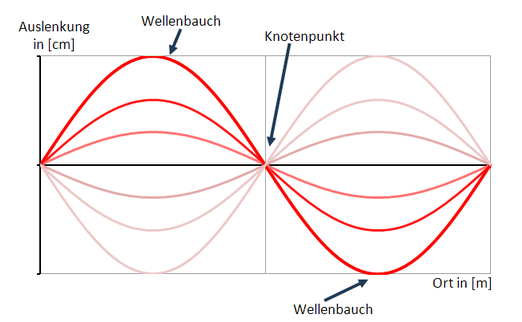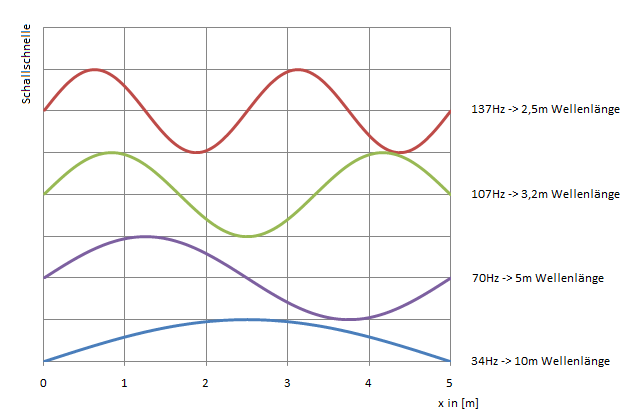3. Bass acoustics - www.hifilounge.eu
Main menu:
- Home
- General
-
Speakers
- Basics
- Speakers
- Headphones
- Subwoofer
- Elektronics
- Surround
- Photography
- Infos
3. Bass acoustics
Speakers > Subwoofer
The subwoofer in the room
At 3khz the sound has a wavelength of about 13 centimeters, at 20hz it is a proud 17 meters. This sentence was already similar to the one above in the text. 120 Hz is a frequency that is already reproduced by the subwoofer in some systems. The wavelength here is about 2.8 meters. The clearly different sizes of the wavelengths have clear consequences for us in practice.
With regard to bass reproduction in living room acoustics, three cases are distinguished:
- The wavelength of the sound is significantly smaller than the dimensions of the cavity - fundamental
- The wavelength of the sound is about as long as the dimensions of the listening room - Bass
- The wavelength of the sound is longer than the listening room - Low bass
The loudspeaker speaks, the room answers. If the response is still reasonably controllable for the music at high frequencies, it is all the more disturbing at low frequencies. How do you set up a subwoofer? According to the advertisements, the subwoofer can simply be placed behind the cabinet where it doesn't look disturbing. For the target group of such brochures the acoustic result might even be sufficient. However, those who have even the slightest expectations should refrain from doing so.
Room modes are an annoying effect of subwoofers due to their placement.
Standing waves or room modes
The real listening room is limited by soundproof walls, ceiling and floor. The boundary surfaces are made of stone and are literally as hard as stone. When sound arrives, the walls will hardly move compared to the much softer air. The sound velocity (or air movement) is therefore inevitably zero at the walls, but the sound pressure is highest directly at the walls. The human ear is a pure pressure receiver, therefore the bass always tends to boom near walls.
If a medium is fixed at several points (walls) and subjected to a frequency whose wavelength fits once or several times into the geometry, standing waves occur. This effect is known from skipping ropes: If the rope is fixed at the ends (wall) and swung with the correct (resonance) frequency, a standing wave occurs.

Figure 1: Standing waves are known from skipping ropes
The swinging rope only knows one direction of propagation for the wave - from the beginning to the end of the rope. In a real listening room, all three spatial directions in x,y and z-direction are suitable for corresponding resonances. These resonances are known as spatial modes.
An example is a normal living room with a square floor area of 5x5 meters. The following figure shows several propagation modes with respect to the sound velocity, on walls at x=0 and x=5 the sound velocity must be zero. For a better overview the curves are arranged one above the other.

Figure 2: Some propagation modes between parallel walls 5 meters away
The sound pressure is at its maximum at those points where the sound velocity has a zero crossing - this is inevitably always true in the direct vicinity of the wall. At 70Hz, however, there is also a resonance point in the middle of the room, for example. At 107Hz there are even two such points in the room at a distance of approx. 1.7m and approx. 3.2m from the wall.
With a square room floor area, the same modes can propagate in two directions simultaneously. In some places the double resonances cause double-amplified booming, in some places the frequencies are completely swallowed up. If the floor area of the room is not square, e.g. a room of 3x5 meters, the room modes in x and y direction are different, furthermore the droning is usually less pronounced.
In principle, the higher frequency waves can also build up to resonance. To do this, only one room length must be an integer multiple of the wavelength. In practice, however, the higher frequencies are not critical, after all a small shelf or chair is enough to reflect the sound wave diffusely and to defuse the potential resonance frequency of the room. For a 70Hz room mode with a wavelength of 5 meters, the usual furnishings are unfortunately not sufficient as they are usually much smaller than the wavelength.
The modes depend only on the room - a changed placement of the speakers can only excite the modes stronger or weaker. How to solve the problem of room modes?
Avoid parallel walls
In many recording studios, the side walls are not designed parallel, square rooms are avoided even more. Whoever wants to build a home cinema from scratch should take this trick to heart. However, if you live in a finished apartment, you will hardly be able to put this advice into practice.
Room mode optimized subwoofer positioning
Whoever owns a subwoofer has both an advantage and a disadvantage in terms of room modes.
The disadvantage is that subwoofers can reproduce very low frequencies and a good subwoofer can therefore stimulate even the lowest room modes.
The advantage is that the subwoofer can be positioned freely in the room without having to consider the stereo triangle between the main speakers and the listening position.
Bass Arrays
How do you get rid of room modes? An elegant but expensive solution is a bass array.
Several subwoofers are placed on the front wall which produce a flat wave. At the rear wall absorbers are used to absorb the wave. The room seems to be infinitely long from an acoustic point of view - the pressure chamber effect disappears, making bass reflex subwoofers capable of low bass even in small rooms, the generation of plane waves neutralizes the room modes in two directions - and by absorbing the returning wave, the room modes are also eliminated in the last remaining room direction.
The realization of the so-called Double Bass Array (DBA) requires a certain creativity in the rear absorbers. In order to absorb deep bass, the absorber plates must be several meters thick. The solution are active absorbers: subwoofers that work with the "wrong" phase position and cancel the incoming sound with anti-noise.
In principle, the rear anti-sound subwoofers can be equipped with microphones and digital electronics to react to the incoming sound waves. In the Praxix, however, a delay element is usually used which, on the basis of the sound wave passing through, allows the rear subwoofers to "wait" until the wave front has arrived at the rear, then the rear subwoofers get going and "swallow" the incoming sound thanks to the inverted phase position.
DBAs dispense with room modes in all three spatial directions. Although this makes the bass very crisp and clean, unfortunately the efficiency of the resulting subwoofer arrangement is below what one would actually expect from such a large number of subwoofers. A level stable DBA should be operated with appropriately resilient drivers and powerful power amplifiers.
A mitigated version of the DBA is the Single Bass Aray (SBA). Here, the anti-noise subwoofer module is not used. The SBA generates a flat wavefront and can therefore suppress modes in two spatial directions. However, the pressure chamber effect is not eliminated and one spatial direction can still contribute to booming modes.
Dipoles
At this point you should know that subwoofers are omnidirectional radiators. Due to the extremely high wavelength, the subwoofer cannot radiate the bass in one direction - quite unlike a tweeter, which has an extreme directivity.
If we could now persuade the subwoofer to send the sound only in the direction of the listener, we would logically have less reflected sound in the room - but instead a rather high proportion of direct sound at the listening position. Subwoofers that can do that really do exist.
These subwoofers are called dipoles or unipole subwoofers. With a dipole subwoofer the bass "cardioid" in form of an 8 is only radiated to the front or the rear. In contrast, a omnidirectional subwoofer produces sound radiation in all directions. Such a concept can be realized, for example, by superimposing the sound radiated forward by a woofer on the sound radiated backward. This partially cancels out the sound from the side of the subwoofer. The advantage of this design is that the room modes, i.e. the room's own resonances, are less excited. Unipole subwoofers with different drivers are a special form. A unipolar subwoofer can be realized with a combination of dipole and monopole subwoofer. A monopole is the already mentioned omnidirectional subwoofer.
The problem with such concepts: they need a clear distance from the wall and usually have an extremely poor efficiency, you need good power amplifiers and high power handling subwoofer drivers to get to acceptable levels.
And another problem: dipoles are pure fast transducers, the opposite is the "pressure transducer". They can only move air, but cannot build up direct pressure. In the far field this balances out again. But if the wavelength of the sound becomes larger than the space, our idea of waves no longer works. You can now imagine the process as in a bicycle pump. Here you have to pump to build up pressure. The quick converter cannot do this - it works in an acoustic short circuit.
Conclusion: Low bass is not possible with dipoles in small rooms.
Room calibration
If you can believe the advertising, you put some lousy subwoofer in the corner behind the sofa, let the room calibration run - and everything is fine. You've got clean, deep, booming-free bass right away. Unfortunately, this is only partly true. A static distribution of the drone spots or bass holes in the room is only possible in a steady state, i.e. if you run a single sine wave over a longer period of time. One could try to adjust the volume with an equalizer - at least for the listening position. The digital calibration does not do anything else by and large.
But there is no such thing as a steady state with music. What happens when different frequencies overlap is a completely different matter. Furthermore, a frequency in the seat on the right-hand side of the sofa may be booming, while at the same frequency it cannot be heard on the armchair on the left. What should the subwoofer do now? Should it make the sound quieter or louder?
In practice, digital readjustment is more like a manicure. It's impossible to plug a bass hole, for this the subwoofer would have to deliver a hundredfold power, which would quickly push the subwoofer to its limits - and lead to murderous booming everywhere else in the room.
However, in case of really annoying droning, especially at the seat, one can readjust and lower the droning peaks a bit. To polish up the bass a bit, such a thing is a fine thing, to compensate a bad set-up is not possible in this way. If you have real problems with booming, you should take a look at the matter, maybe a dealer can help you out.